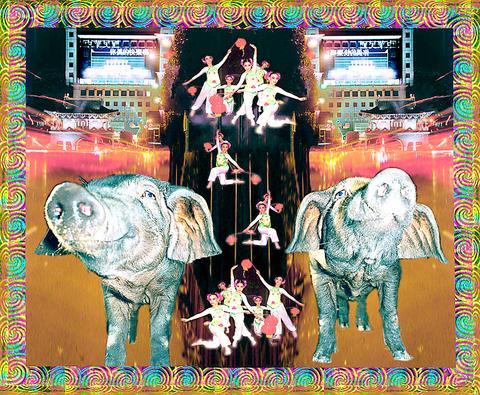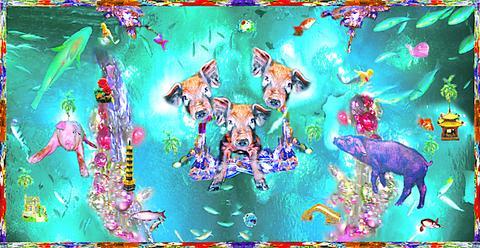In the 1950s, an American movement in photography and literature undertook a top to bottom inventory of its nation and ended up defining a sense of "Americana" through novels like Jack Kerouac's On the Road and photos like Robert Frank's The Americans. Over the last few years Taiwan's photographers have embarked on a similar mission, documenting elements of Taiwanese identity like betel nut girls, Hsimenting kids and the culture of fishing boats and harbors.
The latest contribution to this growing trend comes from female photographer Chang May-ling (

PHOTO COURTESY OF TIVAC
Chang's vision of Taiwan is gaudy and trite, but pretty fun. Using a digital camera and the image blending software Adobe Photoshop, she's packed 18 large prints with collages of Taiwanese icons: betel nuts, the presidential palace, Taipei streetscapes, the national flag, street stall noodles, and above all, betel nut pigs.

PHOTO COURTESY OF TIVAC
In a statement accompanying the exhibition, Chang describes how the pork and betel nut industries are often practically integrated units in southern Taiwan, with the borders of adjacent pig farms frequently marked by hedgerows of betel nut trees. The pigs of these environments, she says, are "betel nut pigs."
Her photo-collages seem to elevate betel nut pigs to embody some quirky approximation of the Taiwanese geist. They're blended with the elemental forces of fire and water. They sing happy songs. They are in paradise. One is urinating, two are having sex. And they're all surrounded with Taiwan's neon glow and hustle and bustle. It's all very cutesy and bright, which is why the show is good to breeze through, but doesn't work on any deep level.
Not that Chang didn't try for a deeper level.
Her artist's statement hints at a double entendre, by which the betel pigs may be replacements for betel nut girls. She writes that the "18 Tricks" in the title indicate both the literal happy-go-lucky tricks performed by the pigs as well as tricks turned by prostitutes. So the work is also an anti-prostitution statement by a conservative feminist, and while the message is valid, it unfortunately only comes off as a flat pun.
All in all, Chang is successful at presenting work that's graphically lively, but unsuccesful at leaving a lasting impression. She would have done better to focus on subtler themes of Taiwaneseness, possibly something she half-discovered in her visual documents.
A theme that's peripheral, mostly undeveloped and much more interesting than her quasi-cartoon pigs would be Taiwan's world of gaudy neon. It's an aesthetic found in night markets, betel nut stands, Taoist temples, and all-night discos. What's interesting is that it knows no social boundaries; it's equally associated with Taiwan's most traditional, most futuristic, most sacred and most corrupt.
Thematically, it or something like it would provide a better vehicle to explore the basic problem of Taiwanese identity: how can a notion of unity come out of so much diversity? Taiwan International Visual Arts Center, TIVAC (

One of the biggest sore spots in Taiwan’s historical friendship with the US came in 1979 when US president Jimmy Carter broke off formal diplomatic relations with Taiwan’s Republic of China (ROC) government so that the US could establish relations with the People’s Republic of China (PRC). Taiwan’s derecognition came purely at China’s insistence, and the US took the deal. Retired American diplomat John Tkacik, who for almost decade surrounding that schism, from 1974 to 1982, worked in embassies in Taipei and Beijing and at the Taiwan Desk in Washington DC, recently argued in the Taipei Times that “President Carter’s derecognition

This year will go down in the history books. Taiwan faces enormous turmoil and uncertainty in the coming months. Which political parties are in a good position to handle big changes? All of the main parties are beset with challenges. Taking stock, this column examined the Taiwan People’s Party (TPP) (“Huang Kuo-chang’s choking the life out of the TPP,” May 28, page 12), the Democratic Progressive Party (DPP) (“Challenges amid choppy waters for the DPP,” June 14, page 12) and the Chinese Nationalist Party (KMT) (“KMT struggles to seize opportunities as ‘interesting times’ loom,” June 20, page 11). Times like these can

JUNE 30 to JULY 6 After being routed by the Japanese in the bloody battle of Baguashan (八卦山), Hsu Hsiang (徐驤) and a handful of surviving Hakka fighters sped toward Tainan. There, he would meet with Liu Yung-fu (劉永福), leader of the Black Flag Army who had assumed control of the resisting Republic of Formosa after its president and vice-president fled to China. Hsu, who had been fighting non-stop for over two months from Taoyuan to Changhua, was reportedly injured and exhausted. As the story goes, Liu advised that Hsu take shelter in China to recover and regroup, but Hsu steadfastly

You can tell a lot about a generation from the contents of their cool box: nowadays the barbecue ice bucket is likely to be filled with hard seltzers, non-alcoholic beers and fluorescent BuzzBallz — a particular favorite among Gen Z. Two decades ago, it was WKD, Bacardi Breezers and the odd Smirnoff Ice bobbing in a puddle of melted ice. And while nostalgia may have brought back some alcopops, the new wave of ready-to-drink (RTD) options look and taste noticeably different. It is not just the drinks that have changed, but drinking habits too, driven in part by more health-conscious consumers and